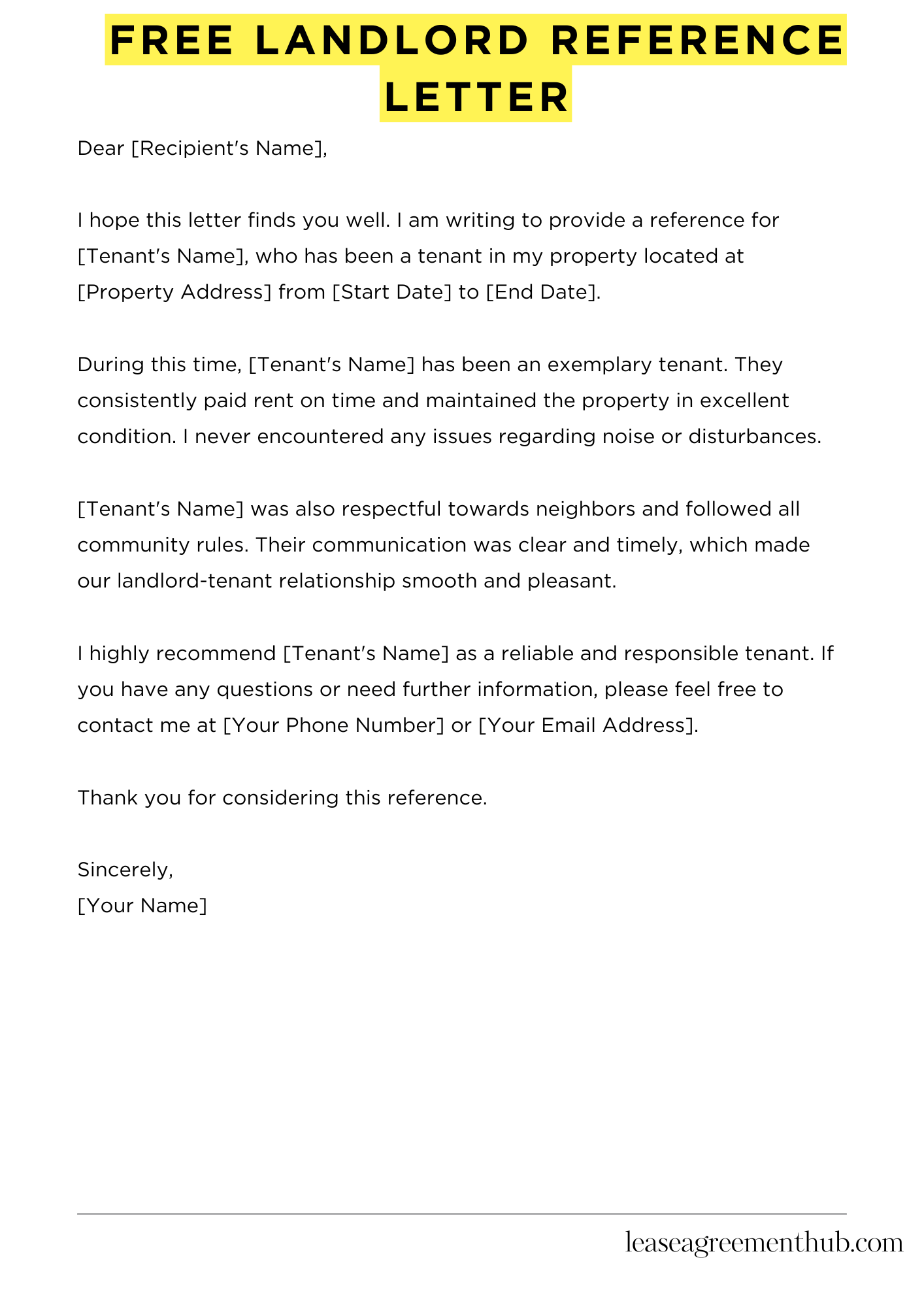A free landlord reference letter is a document that a landlord provides to vouch for a tenant’s character and reliability. Its purpose is to help tenants secure new rental agreements by showcasing their positive qualities. This letter can highlight timely rent payments, good behavior, and overall responsibility.
In this article, we will share various templates and examples of free landlord reference letters. These samples will make it easier for landlords to create their own letters. Whether you need a quick template or a detailed example, we have you covered.
Our goal is to help you write an effective reference letter with ease. You can use our samples to fit your specific needs. This way, you can provide a strong recommendation that helps tenants move forward confidently.
Free Landlord Reference Letter
[Your Name]
[Your Address]
[City, State, Zip Code]
[Email Address]
[Phone Number]
[Date]
[Recipient’s Name]
[Recipient’s Address]
[City, State, Zip Code]
Dear [Recipient’s Name],
I hope this letter finds you well. I am writing to provide a reference for [Tenant’s Name], who has been a tenant in my property located at [Property Address] from [Start Date] to [End Date].
During this time, [Tenant’s Name] has been an exemplary tenant. They consistently paid rent on time and maintained the property in excellent condition. I never encountered any issues regarding noise or disturbances.
[Tenant’s Name] was also respectful towards neighbors and followed all community rules. Their communication was clear and timely, which made our landlord-tenant relationship smooth and pleasant.
I highly recommend [Tenant’s Name] as a reliable and responsible tenant. If you have any questions or need further information, please feel free to contact me at [Your Phone Number] or [Your Email Address].
Thank you for considering this reference.
Sincerely,
[Your Name]

How to Write Free Landlord Reference Letter
Understanding the Purpose of a Landlord Reference Letter
A landlord reference letter is a crucial document. It helps tenants secure new housing by providing potential landlords with insights into a tenant’s rental history. This letter highlights the tenant’s reliability, responsibility, and overall behavior during their time in the property. By writing a strong reference letter, you can greatly assist your tenant in their search for a new place to live.
Gathering Necessary Information
Before you begin writing, collect essential information. You will need the tenant’s full name, the address of the rental property, and the duration of their stay. Additionally, consider including details about their payment history. Were they always on time? Did they ever miss a payment? This information is vital for creating a trustworthy reference.
Structuring Your Letter Effectively
Start with a clear introduction. State your name and position as the landlord. Then, mention the purpose of the letter. The body should cover the tenant’s qualities. Discuss their punctuality with rent, how well they maintained the property, and their interactions with neighbors. Finally, conclude with a strong recommendation. Make it clear that you believe they would be a good tenant for any future landlord.
Using a Professional Tone
While the letter should be friendly, it is essential to maintain a professional tone. Avoid using slang or overly casual language. Stick to clear and concise sentences. This approach not only reflects your professionalism but also enhances the credibility of the reference. Remember, the goal is to provide a reliable account of the tenant’s behavior.
Finalizing and Sending the Letter
Once you have written the letter, review it carefully. Check for any spelling or grammatical errors. A polished letter reflects well on both you and the tenant. After finalizing, print the letter on official letterhead if possible. This adds an extra touch of professionalism. Finally, send the letter to the tenant or directly to the prospective landlord, as per the tenant’s preference.
Related: